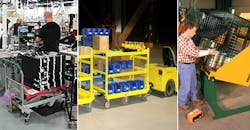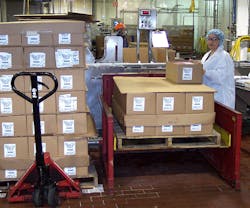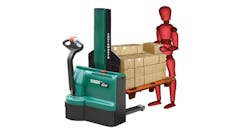Today's "smart" plants leverage the power of IoT, automation, and additive manufacturing to increase efficiencies and output. In this high-tech environment, it's easy to forget about basic lean principles that can reduce or eliminate wasted movements and increase safety.
One of the key areas that manufacturers often overlook is material handling.
"Work cells and workstations are compact, tight areas, and they need to be for operator efficiency, convenience, and effective utilization of costly floor space," says Jim Galante, director of business development at Southworth Products Corp, a maker of ergonomic material handling and positioning equipment.
"This is why operators need equipment that allows them to move material which is often in heavy containers or pallets, from the aisle to their immediate assembly area. You don't want them walking far to pick up material," he says.
In most recent years, manufacturers have been replacing forklifts with smaller, more agile material-handling devices to increase efficiency.
"They're taking a look at how their plants are set up and how to more effectively feed material to workstations," Galante explains.
Carts for Parts
Traditionally, forklifts have been used to deliver large loads of material to assembly line workstations. But forklifts are limited in the amount of material they can deliver and can pose safety risks in high-traffic areas, Galante says.
Towable carts can reduce forklift traffic because material handlers can attach a train of carts to a single tugger.
"A forklift typically carries only one pallet or container at a time," Galante says. "An industrial tugger, which is like driving a golf cart, can pull 10 pallets on towable carts. That's like eliminating 10 forklift trips."
Towable carts can carry both pallets and containers, he says. Carts may help reduce operator movements because they're on wheels. This allows operators to unhook the carts and wheel them next to their assembly area. A forklift operator is usually limited to placing pallets or containers at the edge of the aisle.
"With a forklift, the worker is responsible for retrieving the material from the aisle to his machine or assembly area," Galante says. Towable carts reduce forklift traffic and bring material closer to the assembly area.
Within Arm's Reach
While towable carts bring material closer, they don't address the need to ergonomically position parts at the point of use. Operators often have to bend over or reach for material, which can increase the potential for injuries and reduces productivity, Galante says.
"Most ergonomists say reaching out from the body is worse than bending over," Galante says. "It puts more strain on the lower back than bending over. So just elevating something is not getting the job done. You need to rotate the load around or tilt a container to effectively reduce the reach."
Portable stackers can position pallets or containers so they're within a worker's reach. A stacker is essentially a pallet jack with a built-in lift. A traditional pallet jack moves a pallet from one point to another, but a stacker allows an operator to easily lift the pallet to the assembly table or production line, Galante says.
"If you have a small congested work cell, workstation or area, with maybe 100 to 200 square feet of work area, you may not have room for a hand pallet jack," Galante says. "If the area is that crowded, then a stacker might be better choice than hand pallet jack."
A stacker is more expensive than a hand pallet jack, but manufacturers typically recoup the investment quickly through increased productivity, according to Galante.
A stacker is also an effective way to load a pallet onto a spring or pneumatic level loader.
If operators are moving a container, they can opt for a stacker that comes with tilting functionality. This allows them to tip a container for improved access; this also reduces reach.
"Any time spent moving material or moving a pallet into a workstation is time you're not building that product," Galante says. "With lean manufacturing, if you're not adding value to the customer, you're wasting time."
Selection Criteria
Galante recommends that manufacturers work with their material handling equipment distributors to determine the best approach for their needs. They can help manufacturers determine how much technology they need for particular applications. For example, an auto assembly operation may have different lifting or positioning needs than medical-device plant.
During the selection process, manufacturers should ask themselves:
- What do I want to lift and move?
- How many times a day are workers performing this operation?
- How often do they need to lift or turn pallets or containers?
- How many parts are workers attaching to the main assembly each hour?
This simple evaluation process will help manufacturers decide which device they need to position the container, pallet, or cart.
"The important thing to recognize with material handling equipment is that there is no one magic bullet," Galante says. "Each application needs to be evaluated on what type of work is happening and what kind of equipment is needed to support the worker."
For more information, please visit: www.southworthproducts.com
About the Author

Jonathan Katz
Freelance Editor and Writer
Jonathan Katz, owner of JSK Communications, is a freelance writer with more than 15 years of experience in the publishing industry. He is the former managing editor for Cannabis Business Times and Cannabis Dispensary at GIE Media and a former managing editor of IndustryWeek magazine at Endeavor Business Media.
At IW, Katz covered a wide range of manufacturing topics, including automation, safety, facilities/plant operations and executive leadership.
Prior to freelancing, Katz served as a project manager for Content4Demand, a content marketing agency.



